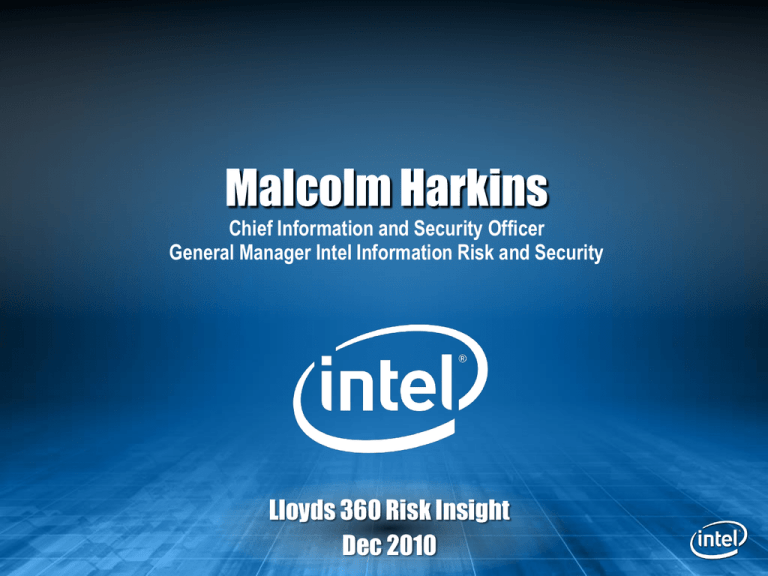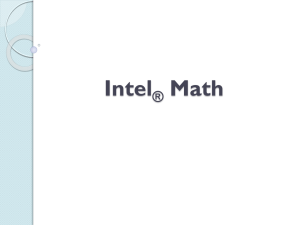
Malcolm Harkins
Chief Information and Security Officer
General Manager Intel Information Risk and Security
Lloyds 360 Risk Insight
Dec 2010
Legal Notices
This presentation is for informational purposes only. INTEL MAKES NO WARRANTIES, EXPRESS OR IMPLIED, IN THIS SUMMARY.
BunnyPeople, Celeron, Celeron Inside, Centrino, Centrino logo, Core Inside, FlashFile, i960, InstantIP, Intel, Intel logo, Intel386, Intel486,
Intel740, IntelDX2, IntelDX4, IntelSX2, Intel Core, Intel Inside, Intel Inside logo, Intel. Leap ahead., Intel. Leap ahead. logo, Intel NetBurst,
Intel NetMerge, Intel NetStructure, Intel SingleDriver, Intel SpeedStep, Intel StrataFlash, Intel Viiv, Intel vPro, Intel XScale, IPLink, Itanium,
Itanium Inside, MCS, MMX, Oplus, OverDrive, PDCharm, Pentium, Pentium Inside, skoool, Sound Mark, The Journey Inside, VTune, Xeon, and
Xeon Inside are trademarks or registered trademarks of Intel Corporation or its subsidiaries in the United States and other countries.
*Other names and brands may be claimed as the property of others.
Copyright © 2009, Intel Corporation. All rights reserved.
“The Perfect Storm”
exposing
Assets
to a loss of
Confidentiality
Integrity
Availability
Vulnerabilities
exploit
increase
Business
Risks
causing
causing
Threats
Legislation
causing
Business
Impacts
reduce
which protect against
Controls
which are mitigated by
Which requires
Identity Mgmt
Assurance
That increase the need for
Intrusion Cycle
People
Adversary
Hacker Group
Organized Crime
Cyber Militia
Nation State
Cyber Terrorism
Spyware
Spam
Phishing
The Web
Assets
Technology
Tradecraft, Tools, Methods – not that different
but the motivation and purpose can differ
Irrefutable Laws of Information Security
1) Information wants to be free
–
People want to talk, post, and share
*Phil Venables 2008, adapted from Scott Culp 2000, Pete Lindstrom 2008, and other sources
Irrefutable Laws of Information Security
1) Information wants to be free
–
People want to talk, post, and share
2) Code wants to be wrong
–
We will never have 100% error free s/w
*Phil Venables 2008, adapted from Scott Culp 2000, Pete Lindstrom 2008, and other sources
Irrefutable Laws of Information Security
1) Information wants to be free
–
People want to talk, post, and share
2) Code wants to be wrong
–
We will never have 100% error free s/w
3) Services want to be on
–
Some background processes will need to be on
*Phil Venables 2008, adapted from Scott Culp 2000, Pete Lindstrom 2008, and other sources
Irrefutable Laws of Information Security
1) Information wants to be free
–
People want to talk, post, and share
2) Code wants to be wrong
–
We will never have 100% error free s/w
3) Services want to be on
–
Some background processes will need to be on
4) Users want to click
–
If they are connected to the internet, people will click on things
*Phil Venables 2008, adapted from Scott Culp 2000, Pete Lindstrom 2008, and other sources
Irrefutable Laws of Information Security
1) Information wants to be free
–
People want to talk, post, and share
2) Code wants to be wrong
–
We will never have 100% error free s/w
3) Services want to be on
–
Some background processes will need to be on
4) Users want to click
–
If they are connected to the internet, people will click on things
5) Even a security feature can be used for harm
–
Laws 2, 3, 4 even apply to security capabilities
*Phil Venables 2008, adapted from Scott Culp 2000, Pete Lindstrom 2008, and other sources
Irrefutable Laws of Information Security
1) Information wants to be free
–
People want to talk, post, and share
2) Code wants to be wrong
–
We will never have 100% error free s/w
3) Services want to be on
–
Some background processes will need to be on
4) Users want to click
–
If they are connected to the internet, people will click on things
5) Even a security feature can be used for harm
–
Laws 2, 3, 4 even apply to security capabilities
Compromise is inevitable under any compute model
Managing the risk and surviving is the key
*Phil Venables 2008, adapted from Scott Culp 2000, Pete Lindstrom 2008, and other sources
So how do you manage the risk and survive?
Predict
Data Enclaving
Endpoint Protection
Prevent
Risk Based Privileges
Predictive Analytics
Detect
Identity &
Access Mgmt
Central Logging Service
Data Correlation/Alerting
Respond
Infrastructure
Protection
Data Protection
Browser Security
Training & Awareness
Security Business
Intelligence
Granular Trust Enablement
Multi-Level Trust
Key Messages
The world has changed, it’s no longer flat
– Mobility and Collaboration is dissolving the internet border
– Cloud Computing is dissolving the Data Center border
– Consumerization will dissolve the enterprise border
The threat landscape is growing in complexity
– Targeted intrusions and attacks leveraging wide-range of vulnerabilities
and growing in sophistication
– Government focus growing – “Industry can’t self-regulate”
The dynamic nature of the ecosystem requires a more fluid but
more granular security model
Security investment needs to keep pace w/changing landscape
Protect, Enable, and Manage the Risk






